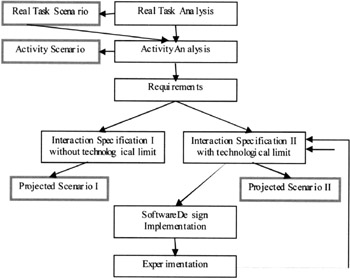3 Design approach
3 Design approach
In the context of archaeological prospecting activities, our work focuses the harmonious fusion of the real world or physical environment with the digital world or data processing in mobile and collaborative situations. The objective is to understand the use of the mobile supports and the services awaited in collaborative situation for a user task in the real world, justifying the fusion of the two worlds, the physical and digital worlds .
Two properties are the bases of our study: transparency of the interaction and ubiquity.
-
The transparency sought in the interaction makes it possible to the user to pay her/his attention on the task to be realised and not on the use of the computer. It is therefore necessary not to separate the user from his physical environment during the use of the computer. The aim is to reduce the contrasts between the two work contexts of the user: there is on the one hand the real world and on the other hand computer equipment and digital information.
-
Ubiquity arises from the use of the mobile supports. The user wishes to reach services and to collaborate with her/his colleagues at any time and from anywhere . The objective is thus to conceive groupware on mobile supports: the user is then no more prisoner of the workstation on her/his desk to be able to collaborate and communicate.
These two properties fall under the current approach of the human computer interaction (HCI) which preaches the universality of the interfaces. The data-processing tool is integrated into the physical environment, accessible from everywhere and by all. To satisfy these two properties, we adopted a design approach based on scenarios [Carroll 00] presented in Figure 19.1. In addition to the recognised interests of a scenario based design approach [Jacobson 95], the fact that the scenarios are centred at the same time on the users and the various tasks makes it possible for us to determine their needs and their relationships to the physical environment.

Figure 19.1: Design steps
As shown in Figure 19.1. from activity scenarios, we carry out a projection of what could be the activity of the users after the introduction of new tools. These future activities are described in projected scenarios. The formalism of the scenarios is described in [Salembier 97]. Based on an empirical analysis of the real task and on an analysis of the activity, we elaborate real task and activity scenarios. They constitute the basic material for the requirement elicitation . Based on the requirements, specifications are then elaborated. Of these specifications, we define projected scenarios. Initially, the specifications are carried out without any limit, by taking account of no constraint. Then in order to be able to develop a concrete platform, we adapt the specifications to the technological limitations. The projected scenarios initially based on these new specifications (II) are used to adjust the specifications (first loop of iteration). After a phase of software design and development, we carry out experimental pre-tests with the end-users. The results may lead to modification of the initial specifications (second loop of iteration).
In [Nigay 2002], we fully describe the design steps and illustrate them. In particular examples of real task and projected scenarios are provided. Having presented the design steps, we now present the outcomes , the designed and developed MAGIC platform.
EAN: 2147483647
Pages: 191